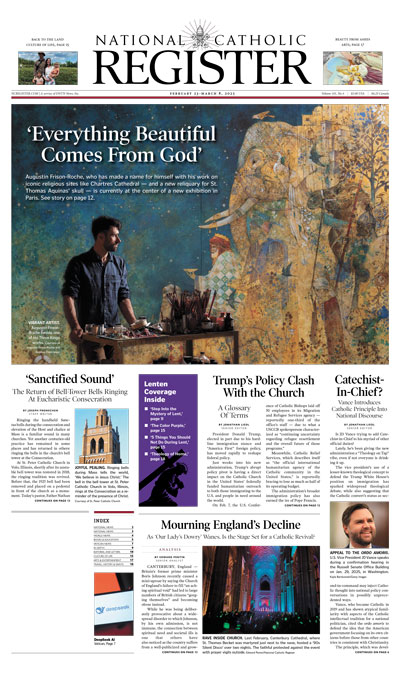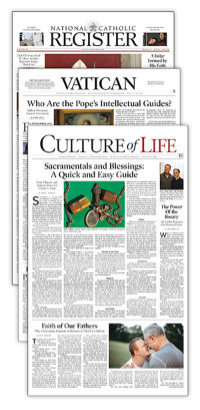Ennio Morricone’s Final Masterpiece: A Mass for the Pope
Best known for his iconic film scores, Morricone’s deep Catholic faith led him to compose a Mass that now stands among his greatest works.

The maestro was a man of routine. Besides not talking much about his work, which consisted of some of the most memorable film scores in movie history, he was a quiet man of prayer. Every morning at about 6 a.m., Ennio Morricone was out on the streets of Rome to get that day’s newspapers and to pray at the nearby Church of the Gesù. It was a routine that caught the eye of the parish’s then-rector, Jesuit Father Daniele Libanori (and auxiliary bishop of Rome from 2018 to 2024), and sparked an idea.
Thinking ahead to the bicentenary of the reconstitution of the Society of Jesus, commemorating the end of the 41-year suppression of the order from 1773 to 1814, Father Libanori envisioned a Mass celebrating the anniversary at the Church of the Gesù. “I spoke about it with the [Jesuit] vice provincial, Father Claudio Barretta, asking him what he thought of the idea of asking Maestro Ennio Morricone to write a score,” Father Libanori recalled to the Register.
While in his mid-80s, Morricone was as prolific as when his career catapulted back in the 1960s, still taking on large-scale Hollywood pictures as well as Italian TV films, like the popular 2005 biopic of Pope John Paul II, Karol: The Man. “Ennio Morricone was one of the greatest composers of his generation,” Irish film composer Patrick Cassidy told the Register, who himself wrote a Mass as well as an opera on Dante. “His musical compositions are timeless and more often than not transcend time and place. They will live for eternity.”
Humble Request
With the vice provincial’s approval, Father Libanori approached the unassuming Morricone one of those early mornings in December 2012. Explaining the significance of the bicentennial of the reconstitution of the Jesuits, Father Libanori asked Morricone if he would compose a Mass — adding at once that he could offer no payment.
The musical genius behind iconic scores such as Sergio Leone’s Dollars trilogy (starring Clint Eastwood), The Untouchables, Cinema Paradiso, and The Mission (which depicted 18th-century Jesuit missionaries in South America) listened intently. “Yes,” he immediately agreed, already envisioning the orchestra and choir that would be needed, according to Father Libanori.
Father Libanori was delighted, as Morricone, a lifelong Catholic, told the priest that his wife Maria had long urged him to compose a Mass, which he always resisted until that moment. As Morricone spoke rapidly about his vision — to include trumpets, wind instruments, cellos, violins and 100 choristers — Father Libanori wondered if the multiple-Oscar-nominated composer had not heard the part about not getting paid for his work.
Father Libanori also said that Morricone “saw my request as the fulfillment of a plan that had begun with the music for The Mission.” Indeed, of the seven pieces that would become Missa Papae Francisci, the “Finale” incorporates the triumphant track from The Mission, On Earth as It Is in Heaven.
Creative Crisis Averted
But that was still in the future. Only two weeks later, Morricone phoned Father Libanori and asked if he might pay a visit to the Morricone home, some 200 yards from the Church of the Gesù. “He welcomed me into his home and, full of embarrassment, said, ‘You must release me from the commitment I have made because I really can’t [do it]’,” Father Libanori recalled. Morricone’s son, Marco, told the Register, “Because he had no constraints of any kind, neither of time nor space, all this freedom to roam created difficulties precisely because of this great freedom.”
Hearing out the maestro’s creative crisis, Father Libanori noticed Morricone’s wife, Signora Maria, seated next to her husband, smiling. The Jesuit then replied, “Maestro, no one has set a time. You will write when the inspiration comes to you.” Father Libanori sensed that this relieved Morricone and made Signora Maria happy. “I believe that Maestro Morricone’s music owes a lot to the sense of serenity and balance that Signora Maria instilled in him,” Father Libanori said.
Mass Masterpiece
Not two months later, the Mass was complete. Morricone handed over his composition with measures traced in pencil for all the instruments required. Father Libanori delivered that original sheet to the provincial archives of the Jesuits with a copy of the score for the conductor.
The writing of the Mass just happened to coincide with the unexpected conclave in the wake of Pope Benedict XVI’s resignation and election of the first member of the Society of Jesus to the papacy, Jorge Bergoglio.
The title of Morricone’s Mass, Missa Papae Francisci, was a nod to both the new Pope’s Jesuit background as well as a spiritual continuation of the Jesuit-themed The Mission, as Morricone originally intended. However, as Father Libanori humorously pointed out, the choir consisted of 50 members, not 100 as first envisioned.
At last, the Mass premiered on June 10, 2015, in a performance at the Church of the Gesù. Morricone conducted the Orchestra Roma Sinfonietta, with whom he had collaborated since 1995 for his live performances and music scores.
Papal Presentations
Later, Morricone gave a copy of the score to Pope Francis himself. “When my dad, mom and the Holy Father met for the first time, my parents burst into tears that would not stop,” Marco remembered. “The Pope looked on, both shocked and embarrassed.” Marco thought his father was drawn to Pope Francis’s simplicity and charisma.
Like any good Jesuit, Pope Francis did not let the opportunity go unseized. For the close of the Year of Mercy in November 2016, the Pontiff tapped Morricone to conduct “Concert With the Poor and for the Poor” in the Vatican’s Paul VI Audience Hall. Guests of honor were homeless people and migrants, who were entertained by some of Morricone’s own work, including selections from The Mission.
During the Great Jubilee in 2000, Morricone participated in the Jubilee of Artists symposium on “The Church and Art in the Pilgrimage Towards God.” Morricone presented on “The Artist and Music as a Means of Opening Towards the Sacred.”
“He deeply loved Girolamo Frescobaldi, Pierluigi da Palestrina, Monteverdi, Johann Sebastian Bach,” Marco recalled. “But as a young boy, he was indelibly struck by Igor Stravinsky’s Symphony of Psalms, which, I think, deeply affected him. Every time [my father] spoke about it, he became emotional, showing his fragility without inhibitions.”
Prayerful Composer
Although a private and reserved person, “Dad was a deeply religious man,” Marco said. “During the day, when he wasn’t working, you would find him silent and moving his lips slightly. And we discovered, over time, that he [was] praying.”
Ennio Morricone died in Rome in July 2020. He was 91. The relationships that developed out of Morricone’s musical contributions, and by extension his faith, however, were secured.
“Fate wanted Father Libanori to become the spiritual father of Dad and Mom,” Marco said, noting that Father Libanori also celebrated the wedding of Ennio’s granddaughter, Francesca, in 2022.
In 2019, Pope Francis honored Morricone with the Gold Medal of the Pontificate, presented to the composer by Cardinal Gianfranco Ravasi at Sant’Agnese in Agone Church in Rome.
“I will always thank him for having transmitted to me, with his example, the values that I carry with me,” Marco said of his composer father. “I terribly miss his silences that were, in the end, really assents.”
- Keywords:
- ennio morricone
- pope francis health
- catholic mass















